This article has been reviewed according to Science X's editorial process and policies. Editors have highlighted the following attributes while ensuring the content's credibility:
fact-checked
peer-reviewed publication
trusted source
proofread
Global study shows that most cities receive more rainfall than surrounding rural areas

The effect of urbanization on temperature is relatively well-known: cities are often measurably warmer than their surrounding rural areas. This is called the urban heat island effect. What fewer people know is that the urban heat island has a twin counterpart with similarly important consequences: the urban precipitation anomaly, where the presence of urban development measurably affects the amount of rainfall in an area.
In a study published in Proceedings of the National Academy of Sciences, researchers at The University of Texas at Austin looked for evidence of precipitation anomalies in 1,056 cities across the globe and found that more than 60% of those cities receive more precipitation than their surrounding rural areas.
In some cases, the difference can be significant. For instance, researchers found that Houston, on average, will receive almost 5 inches more rain per year than its surrounding rural areas.
This could have wide-ranging implications, the most serious of which is worsened flash flooding in densely built urban areas.
Variation in urban rainfall is something scientists have known about for several decades, but never at a global scale. Previous studies only looked at certain cities and storm cases, said study author Xinxin Sui, a doctoral student at the Cockrell School of Engineering. For this paper, she and other researchers poured over precipitation datasets from satellites and radar systems, examining daily precipitation anomalies for these 1,056 cities from 2001 to 2020.
"In general, we found that over 60% of these global cities have more rainfall (than the surrounding countryside). Then we compared with different climate zones and found that if the local climate is hotter, if it's wetter, then it may have a larger rainfall anomaly compared to the cities in cooler and dryer places," Sui said.
In addition to Houston, the list of large cities with the largest precipitation anomalies include Ho Chi Minh, Vietnam; Kuala Lumpur, Malaysia; Lagos, Nigeria; and the Miami-Fort Lauderdale-West Palm Beach metropolitan area.
Study author Dev Niyogi, a professor at both the Jackson School of Geosciences and Cockrell School of Engineering, explained that urban areas tend to take rain from one location and concentrate it in another, much like a sponge that is being squeezed.

"If you were to pinch one part of the sponge, you would have water coming down more forcefully from one side," he said. "The amount of water you have in the sponge is the same, but because now you have that dynamic sort of squeezing the atmosphere, you have more ability to take the water out from that location."
Although it's less common, some urban areas actually receive less rainfall than their surrounding rural counterparts. This typically occurs in cities situated in valleys and lowlands, where precipitation patterns are controlled by nearby mountains. The cities where this is most pronounced include Seattle, Washington; Kyoto, Japan; and Jakarta, Indonesia.
There are several reasons why most cities receive more rainfall than their rural neighbors. Co-author Liang Yang, professor at the Jackson School, said one key factor is the presence of tall buildings, which block or slow down wind speeds. This leads to a convergence of air toward the city center.
"The buildings further enhance this convergence by slowing the winds, resulting in a stronger upward motion of air. This upward motion promotes the condensation of water vapor and cloud formation, which are critical conditions for producing rainfall and precipitation," Yang said.
Researchers found that population has the largest correlation with urban precipitation anomalies compared to other environmental and urbanization factors. This is because larger populations typically create denser and taller urban areas, along with more greenhouse gas emissions, and therefore more pronounced heat, Niyogi said.
This phenomenon has implications for all cities heading into a future of climate change, said Yang, who described how the increased chances of rainfall in cities combined with the impervious surfaces that make up their urban environments can be a recipe for flash flooding.
"Combining these two factors means we must develop innovative ways to prepare for flash flooding," Yang said.
More information: Niyogi, Dev, Global scale assessment of urban precipitation anomalies, Proceedings of the National Academy of Sciences (2024). DOI: 10.1073/pnas.2311496121. doi.org/10.1073/pnas.2311496121
Journal information: Proceedings of the National Academy of Sciences
Provided by University of Texas at Austin





















